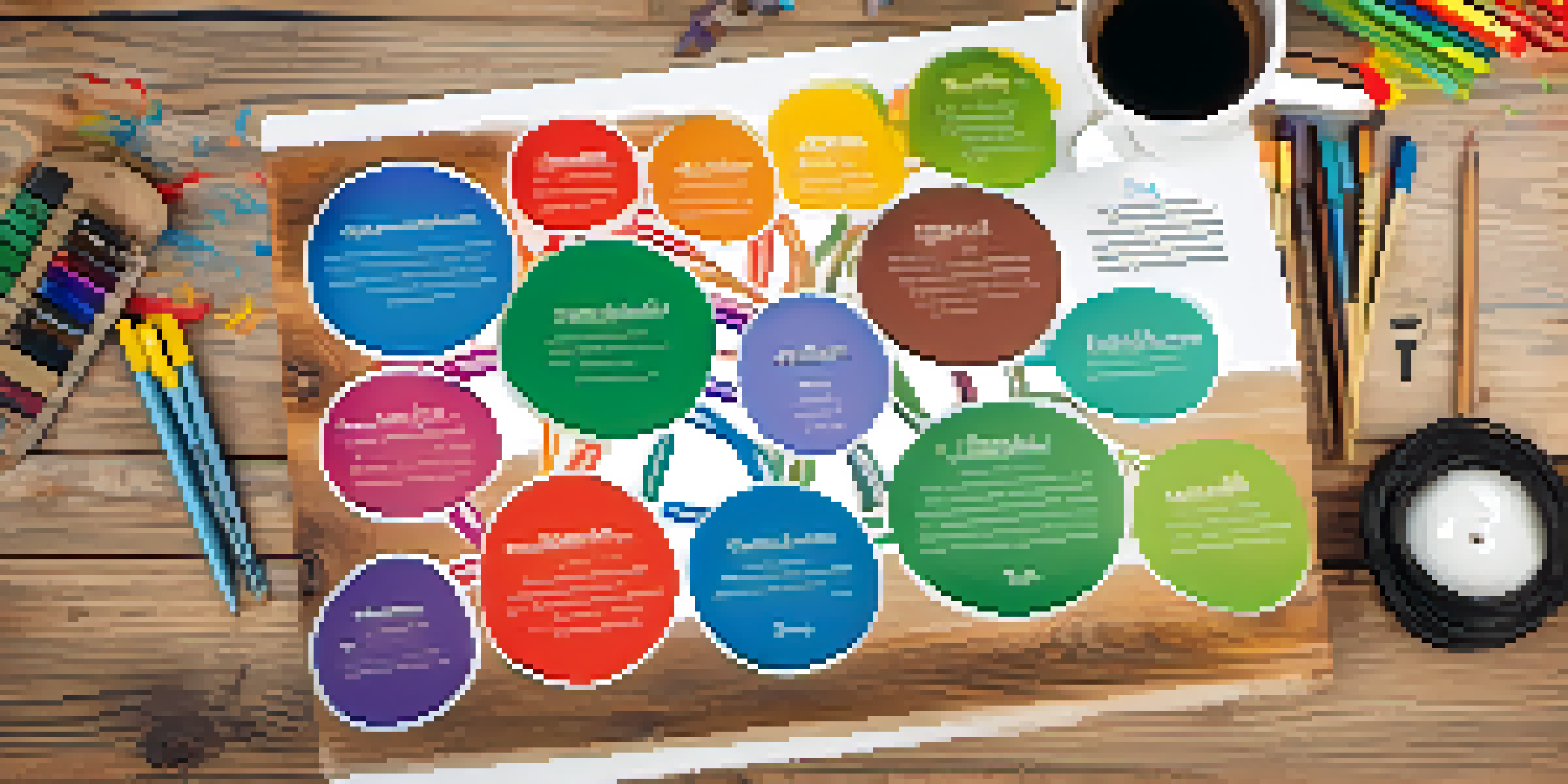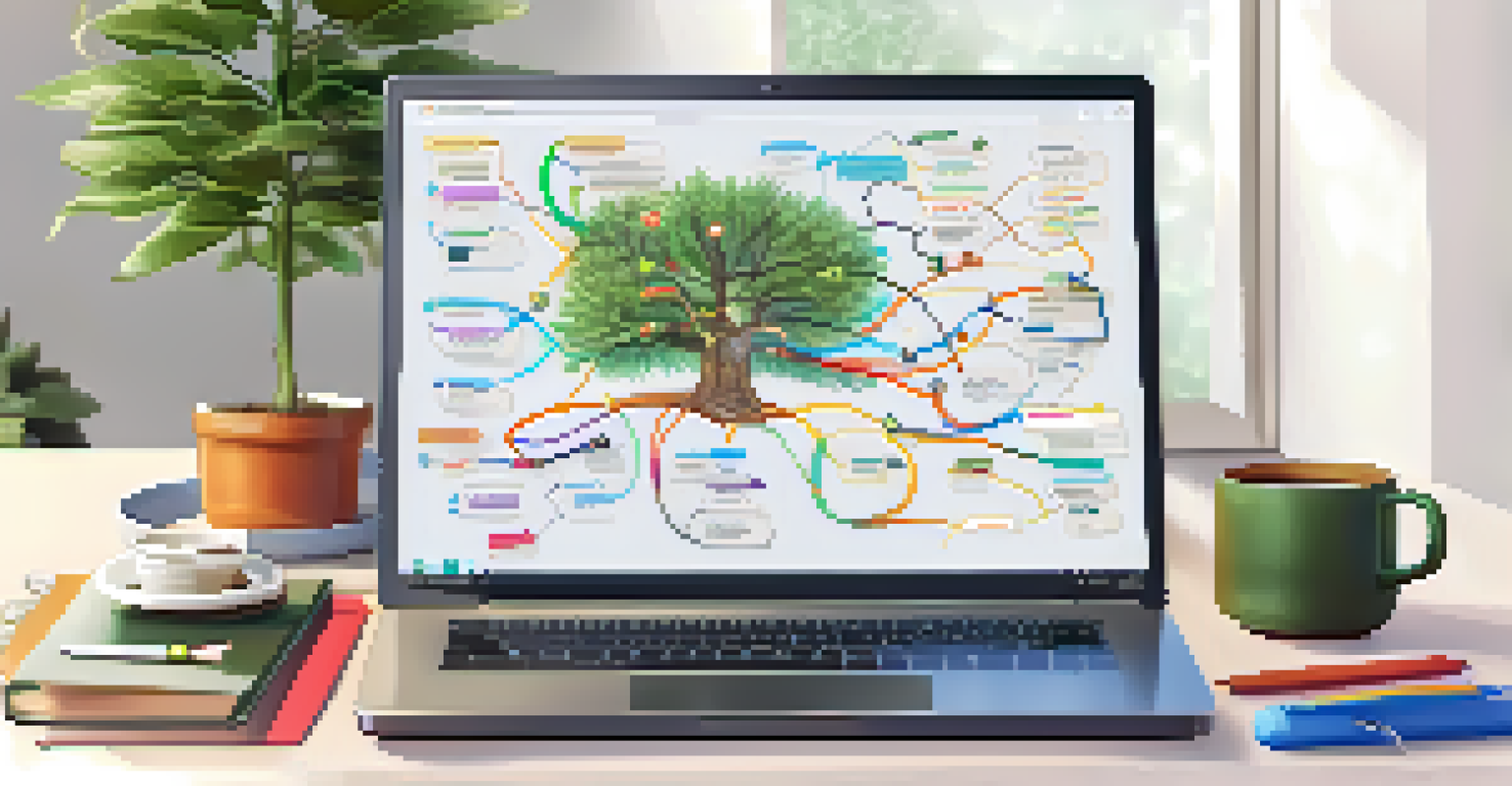Mind Mapping Techniques for Students: Enhance Learning

Understanding Mind Mapping: A Visual Learning Tool
Mind mapping is a powerful visual tool that helps students organize information. By using diagrams to represent ideas and concepts, students can see relationships and connections more clearly. This technique is particularly useful for breaking down complex subjects into manageable parts, making learning less daunting.
The mind is like a parachute. It doesn't work if it is not open.
Imagine a tree, where the trunk represents the main idea, and the branches symbolize related topics. This structure helps students categorize information and enhances recall. It's not just about making notes; it’s about creating a visual representation of knowledge that feels more engaging and less like traditional studying.
Many students find that they remember information better when they can visualize it. Mind maps tap into this natural inclination, making studying a more interactive and enjoyable experience. By incorporating colors, images, and symbols, students can make their maps more memorable, turning study sessions into creative exercises.
How to Create an Effective Mind Map
Creating a mind map starts with a central idea placed in the center of a blank page. From there, students can draw branches for major topics related to that idea. Each branch can further divide into smaller subtopics, allowing for a hierarchical organization of information that’s easy to follow.

Encouraging creativity in this process is key. Students can use different colors and shapes to differentiate between various branches or levels of information. This not only makes the mind map visually appealing but also helps in categorizing details, which enhances memory retention.
Mind Mapping Enhances Learning
Mind mapping helps students organize information visually, making complex subjects easier to understand and remember.
Once the basic structure is in place, students can add images, symbols, or keywords that resonate with them. The more personal and unique the mind map is, the more effective it will be in aiding their learning. It’s about making the information relatable and easier to digest.
Benefits of Mind Mapping for Students
Mind mapping offers numerous benefits that can significantly enhance a student’s learning experience. It promotes active involvement in the learning process, encouraging students to think critically about how information is interconnected. This active engagement can lead to deeper understanding and better retention of concepts.
Creativity is intelligence having fun.
Additionally, mind maps can reduce the feeling of overwhelm that often comes with studying complex subjects. By breaking down material into visually digestible pieces, students can tackle one section at a time, making studying feel less intimidating and more manageable.
Moreover, mind mapping can be a collaborative tool. Students can work together to create mind maps, sharing ideas and perspectives that enrich their understanding. This collaborative aspect fosters teamwork and communication skills, which are invaluable in both academic and professional settings.
Mind Mapping Tools and Software for Students
In today’s digital age, there are countless mind mapping tools and software available that can help students create their maps more efficiently. Programs like MindMeister, XMind, and Coggle offer user-friendly interfaces, allowing students to create dynamic and colorful mind maps easily. Many of these tools also include templates, making it even easier to get started.
Using software can enhance the mind mapping experience by allowing students to easily edit and rearrange their ideas. This flexibility is particularly useful when new information arises or when students need to adapt their maps for different subjects or projects.
Effective Mind Map Creation Tips
To create an effective mind map, start with a central idea and use colors and images to enhance engagement and memory retention.
Additionally, many of these tools offer collaboration features, enabling students to work together in real-time, even from different locations. This fosters a sense of community and makes studying a more interactive experience, as students can brainstorm and develop ideas collectively.
Integrating Mind Mapping into Study Routines
Integrating mind mapping into regular study routines can significantly enhance a student’s learning efficiency. For example, students can use mind maps for summarizing chapters after reading, helping them to consolidate their understanding. This practice not only reinforces learning but also provides a quick reference for future review.
Moreover, mind mapping can be particularly effective during exam preparation. By creating mind maps that cover key topics, students can visualize the entire syllabus at a glance, ensuring they don’t miss important areas. This method encourages a holistic view of the material, which is essential for comprehensive understanding.
Establishing a habit of mind mapping can also promote better time management. Students can allocate specific periods for creating and revising their maps, turning study sessions into productive and focused activities. This structured approach helps in managing workload and reduces last-minute cramming.
Mind Mapping for Different Learning Styles
One of the great advantages of mind mapping is its adaptability to different learning styles. For visual learners, the colorful diagrams and images can make information more accessible and engaging. Kinesthetic learners can benefit from the act of creating the map itself, using their hands to draw and arrange ideas.
Auditory learners can also find value in mind mapping by discussing the content with peers while creating the map. This combination of listening and visual organization helps reinforce their understanding, making the learning experience more comprehensive.
Mind Mapping Supports Collaboration
Mind mapping can be a collaborative tool, allowing students to work together, share ideas, and strengthen communication skills.
Furthermore, mind mapping encourages students to explore their unique learning preferences. By experimenting with different styles of mind mapping, such as digital versus hand-drawn, students can discover what works best for them, ultimately leading to more effective study habits.
Overcoming Challenges with Mind Mapping
While mind mapping is a powerful tool, some students may encounter challenges when first trying it out. One common issue is the initial struggle to organize thoughts effectively. To overcome this, students can start simple, focusing on one topic at a time, and gradually expand their maps as they become more comfortable.
Another challenge is maintaining clarity in increasingly complex maps. To address this, students should prioritize simplicity; using keywords instead of long phrases can help keep the map clear and concise. Encouraging regular revisions can also prevent overcrowding and ensure that the mind map remains a useful study tool.

Finally, some students might feel overwhelmed by the creative aspect of mind mapping. To ease this pressure, it’s important to remember that mind maps don’t need to be perfect; they are personal tools meant to aid learning. Emphasizing the process over the final product can help students enjoy the journey of discovery rather than stressing about aesthetics.